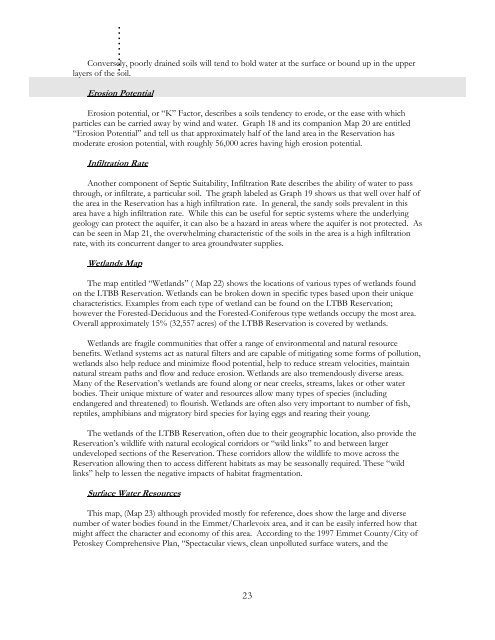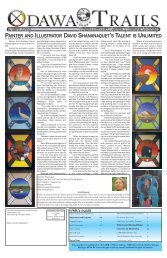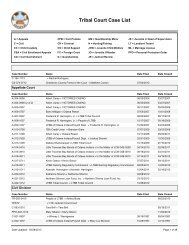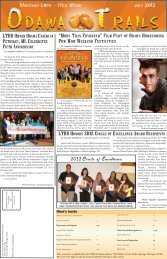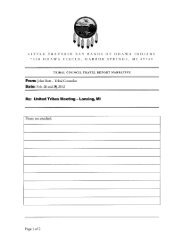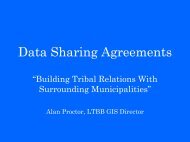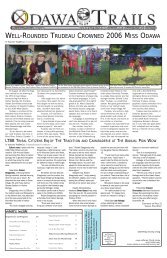LTBB Master Land Use Plan - Little Traverse Bay Bands of Odawa ...
LTBB Master Land Use Plan - Little Traverse Bay Bands of Odawa ...
LTBB Master Land Use Plan - Little Traverse Bay Bands of Odawa ...
You also want an ePaper? Increase the reach of your titles
YUMPU automatically turns print PDFs into web optimized ePapers that Google loves.
.<br />
Conversely, poorly drained soils will tend to hold water at the surface or bound up in the upper<br />
layers <strong>of</strong> the soil.<br />
Erosion Potential<br />
Erosion potential, or “K” Factor, describes a soils tendency to erode, or the ease with which<br />
particles can be carried away by wind and water. Graph 18 and its companion Map 20 are entitled<br />
“Erosion Potential” and tell us that approximately half <strong>of</strong> the land area in the Reservation has<br />
moderate erosion potential, with roughly 56,000 acres having high erosion potential.<br />
Infiltration Rate<br />
Another component <strong>of</strong> Septic Suitability, Infiltration Rate describes the ability <strong>of</strong> water to pass<br />
through, or infiltrate, a particular soil. The graph labeled as Graph 19 shows us that well over half <strong>of</strong><br />
the area in the Reservation has a high infiltration rate. In general, the sandy soils prevalent in this<br />
area have a high infiltration rate. While this can be useful for septic systems where the underlying<br />
geology can protect the aquifer, it can also be a hazard in areas where the aquifer is not protected. As<br />
can be seen in Map 21, the overwhelming characteristic <strong>of</strong> the soils in the area is a high infiltration<br />
rate, with its concurrent danger to area groundwater supplies.<br />
Wetlands Map<br />
The map entitled “Wetlands” ( Map 22) shows the locations <strong>of</strong> various types <strong>of</strong> wetlands found<br />
on the <strong>LTBB</strong> Reservation. Wetlands can be broken down in specific types based upon their unique<br />
characteristics. Examples from each type <strong>of</strong> wetland can be found on the <strong>LTBB</strong> Reservation;<br />
however the Forested-Deciduous and the Forested-Coniferous type wetlands occupy the most area.<br />
Overall approximately 15% (32,557 acres) <strong>of</strong> the <strong>LTBB</strong> Reservation is covered by wetlands.<br />
Wetlands are fragile communities that <strong>of</strong>fer a range <strong>of</strong> environmental and natural resource<br />
benefits. Wetland systems act as natural filters and are capable <strong>of</strong> mitigating some forms <strong>of</strong> pollution,<br />
wetlands also help reduce and minimize flood potential, help to reduce stream velocities, maintain<br />
natural stream paths and flow and reduce erosion. Wetlands are also tremendously diverse areas.<br />
Many <strong>of</strong> the Reservation’s wetlands are found along or near creeks, streams, lakes or other water<br />
bodies. Their unique mixture <strong>of</strong> water and resources allow many types <strong>of</strong> species (including<br />
endangered and threatened) to flourish. Wetlands are <strong>of</strong>ten also very important to number <strong>of</strong> fish,<br />
reptiles, amphibians and migratory bird species for laying eggs and rearing their young.<br />
The wetlands <strong>of</strong> the <strong>LTBB</strong> Reservation, <strong>of</strong>ten due to their geographic location, also provide the<br />
Reservation’s wildlife with natural ecological corridors or “wild links” to and between larger<br />
undeveloped sections <strong>of</strong> the Reservation. These corridors allow the wildlife to move across the<br />
Reservation allowing then to access different habitats as may be seasonally required. These “wild<br />
links” help to lessen the negative impacts <strong>of</strong> habitat fragmentation.<br />
Surface Water Resources<br />
This map, (Map 23) although provided mostly for reference, does show the large and diverse<br />
number <strong>of</strong> water bodies found in the Emmet/Charlevoix area, and it can be easily inferred how that<br />
might affect the character and economy <strong>of</strong> this area. According to the 1997 Emmet County/City <strong>of</strong><br />
Petoskey Comprehensive <strong>Plan</strong>, “Spectacular views, clean unpolluted surface waters, and the<br />
23


